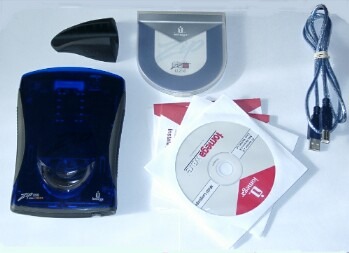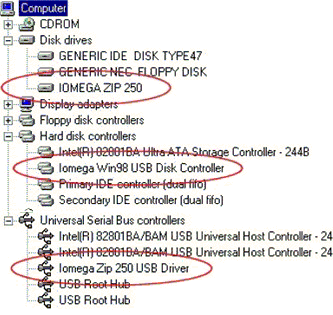A Zip drive... how much it means for a PC or MAC
user! Drives of this type take one of the first places in the market
of storage devices with removable discs. Advantages
and disadvantages of the disc technology used in
such storage devices are well known. There was a time when Zip disc drives intended to
replace usual floppy disc drives, but it didn't happen, and they
formed an independent class with even some competition in it: remember
LS-120 and little known HI-Fd. But Zip devices were coping with
their task quite successfully. Zip family was developing. The capacity
of Zip drives increased dramatically, new interfaces appeared. Today,
mobile models of Zip devices are the most attractive solution. But until now
Zip devices had one unpleasant drawback - they required an external
power supply. And at last Iomega has introduced an advanced model
- the Zip250 USB Host Powered. This modern solution doesn't require any
external power supply. So, let's take a close look at it.
ZIP 250 MBytes USB (HOST POWERED)
Specifications:

- Interface: USB
- Disc capacity: 250 MBytes or 100 MBytes
- Disc rotation speed: 2941 RPM
- Data transfer rate:
- average - up to 900 KBytes/s
- maximum - up to 1 MBytes/s
- Typical bandwidth: up to 55 MBytes/min
- Average access time: 50 ms
- Spin-down/spin-up time: 5/8 s
- Long Format 8-10 min
- Short Format 10 s
- Dimensions: 163.6 mm x 101.4 mm x 25.4 mm
- Weight: 400g
Now let's look inside the box. A pretty drive is made
of semitransparent plastic. Rubber side straps make the drive fix
properly in a vertical position by means of a prop supplied.
As compared with earlier Zip drives this model is thinner and more
compact. But on the other hand, the case of the drive is, in my opinion,
a bit fragile and untight. For a device primarily intended for mobile
use it is not very good.

In the box you can also find a USB-cable, software
and booklets with a short installation guide, and a 250 MBytes
disc of U-shape type. As compared with usual diskettes such discs
have a futuristic form and titanic embeddings for better data keeping
and longer diskette utilization. U-shape diskettes are supported
with a 10-year warranty. The usual (for standard ZIP storage devices) Clean-as-you-go(tm)
and Spin Control(tm) technologies
are used for their production.

Drive controls are very ascetic: the front panel
has only an eject button combined with an operation indicator, plus
an emergency ejection hole which is also located in this button. The slot
for disc loading is covered with a standard shutter. On the rear panel
of the drive there is a USB-connector of "B" type for connecting
the device to a computer. The drive is powered via a USB-bus through
the same connector.
Installation
There are two ways of installation of this drive: 1.) to install
the IomegaWare packet and connect the drive (then the system
itself installs the required drivers and programs); 2.) to connect
the drive to a computer, and on the system's request you have
to specify the location of drivers on a CD. In the latter case you get
a well functioning drive, though you are not able to work with password
protected diskettes. And with IomegaWare you get the access
to all capabilities of the drive. The connection of the device to a
computer lies only in connecting a USB-cable.
Here you can see how the drive looks like in
the system registry after installation.

Operation
The connection method of the disc drive, when
power is supplied and data are transferred via the same cable and
no external power sources are required, makes it very attractive
for a mobile user. Though, as I have mentioned, I wish it were
more solid and hermetic. This drawback could be eliminated
with supply of a transportation case, this could make a user less worried
about possible dust penetration or accidental damage. Switching
on/off causes no problems, P-n-P functions work flawlessly. But
remember that disabling the device during data recording with
the indicator on can bring about a "blue death screen". Like the previous models the drive makes
quite much noise. During a 2-minute installation
process one can hear rather unpleasant sounds. The connection of the drive can
slow down the system if there isn't a diskette inside. Data are usually transferred
from a computer to a disc via caches in the system, that
is why it is no wonder when in a file-manager a transfer process
stops and the drive is completing the task for
several other minutes. Our attempt to eject a disc during the operation
failed. In the course of data transfer the eject button is locked
until the process is finished. An emergency ejection is possible
only when the device is off - otherwise you can damage not only
a disc but also the device.
The speed characteristics of the disc drive were measured
with the Winbench99 program.

Disk Transfer Rate: Begin - 955 kBytes/s , End
- 900 kBytes/s
Disk Access Time: 61.2 ms
Disk CPU utilization : 7.5 %
As you can see, the drive is limited by a USB bus
bandwidth. I'd like to think that USB can transfer data up to
1.5 mBytes/s, but it's wrong: the bus reserves data transfer channels
for slow devices (keyboard, mouse), and for service data. And as
a result, there can be not more than 1 mBytes/s for storage devices.
In the table below you can see the specifications of the Zip100 USB.
WinBench99
| |
Business Disk WinMark, thousands bytes/sec |
Disk Transfer Rate (beginning), thousands
bytes/sec |
Disk Transfer Rate (end), thousands bytes/sec |
Disk Access Time, ms |
Disk CPU Utilization, % |
| ZIP250 USB |
554
|
955
|
900
|
61.2
|
7.5
|
| ZIP100 USB |
486
|
732
|
674
|
52.8
|
24.2
|
Let's consider the data record rate. Here we used
a simple test. We carried out the copying of a large file (98 MBytes)
and 500 small files the total size of which makes 60 MBytes. Below
you can compare the results with those of the Zip100 USB.
Zip100 and Zip250 Write DiskTest
| |
DiskTest (98 mBytes -1 file), kb/sec |
DiskTest (60 mBytes - 500 files), kb/sec |
| Zip100 USB |
580
|
420
|
| Zip250 USB powered |
723
|
550
|
As you can see, when copying a great number of
small files the record rate falls considerably.
Now a bit on compatibility of the Zip250 drive
with old format diskettes of 100 MBytes. Of course, the ZiP250
can read and record old format diskettes, but look at the figures.

Disk Transfer Rate: Begin - 950 KBytes/s , End
- 819 KBytes/s
Disk Access Time: 55 ms
Disk CPU utilization : 7.53 %
100 MBytes diskettes are read nearly at the same
speed as 250 MBytes ones. Now as for the data recording test. Iomega
notifies of a slower recording rate of 100 MBytes diskettes, let's
check the figures. The settings are the same as in the
previous test for a 250 MBytes disc. The table below shows the results
of both 100 MBytes and 250 MBytes discs.
100 MBytes and 250 MBytes Write DiskTest
| |
DiskTest (98 MBytes -1 file), kb/sec |
DiskTest (60 MBytes - 500 files), kb/sec |
| 100 MBytes Disk |
122
|
110
|
| 250 MBytes Disk |
723
|
550
|
For 100 MBytes diskettes the recording rate
is very low, but it is OK if you are not in a hurry. Especially considering
that it is still higher than that of, for example, the Zip LPT.
Conclusion
The Zip250 USB Host powered is a real pink of
perfection of Zip storage devices. This stylish, light, comfortable
drive ideally suits for mobile use, since it doesn't require any
external power source. Today a USB bus can be found both in mobile
and desktop computers. So, you can use a USB ZIP
drive practically in any place. I wish only that the case were
more hermetic and the drive were supplied with a transportation
case.
Write a comment below. No registration needed!






